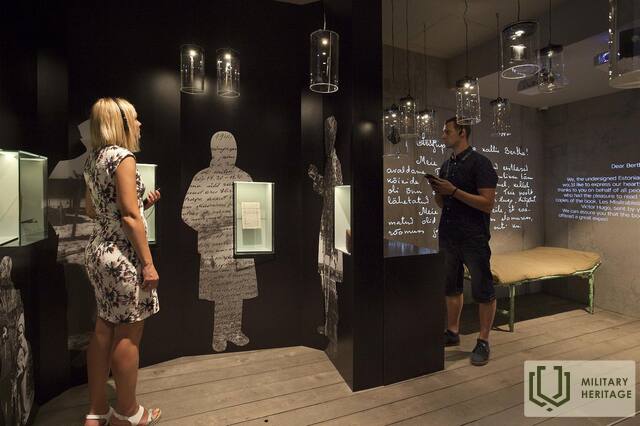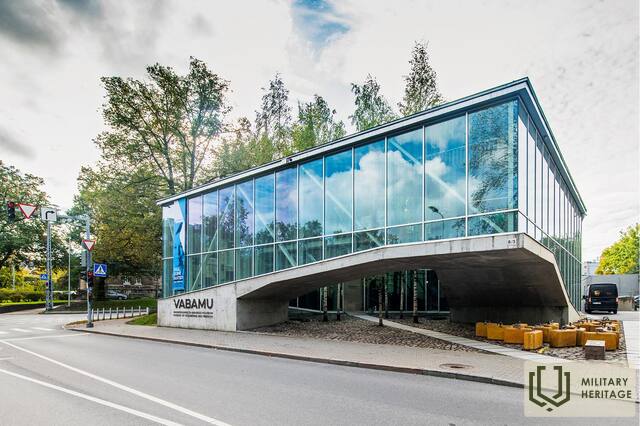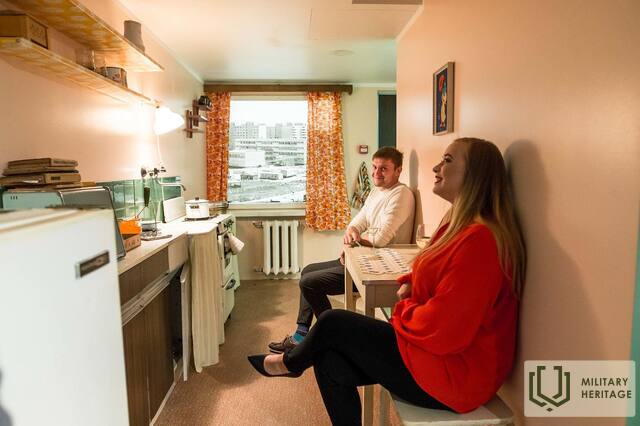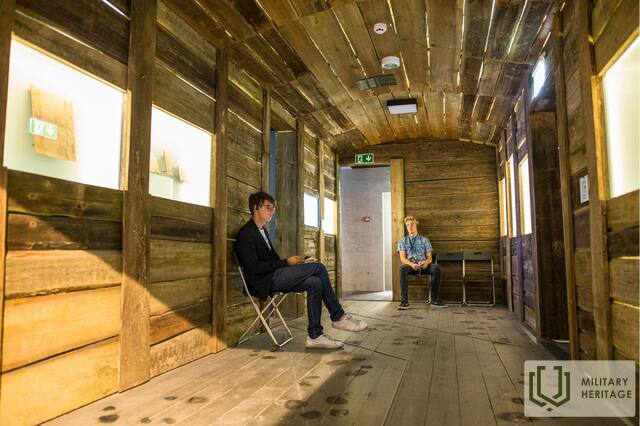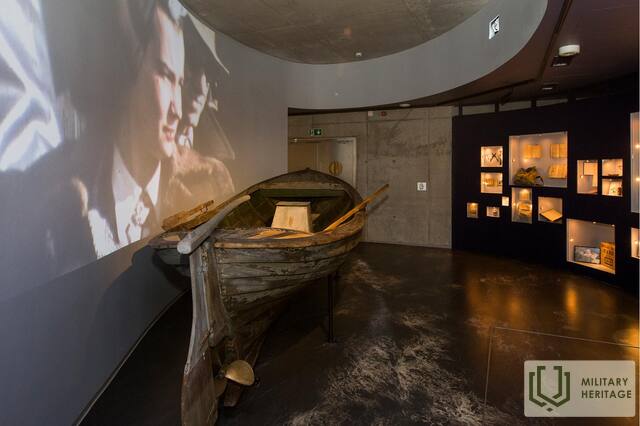Vabamu Museum of Occupations and Freedom Museum

Vabamu museum is situated in the centre of Tallinn.
A private museum, it opened in 2003 to showcase Estonian history from 1940-1991. The museum recalls stories from recent history highlighting both the value and fragility of freedom.
The main exhibition and the films shown at the museum provide an overview of the Soviet occupation, oppression, national resistance and the Singing Revolution.
The main exhibition, ‘Freedom Has No Limits’, is divided into five topics: ‘Inhumanity’, ‘In Exile’, ‘Soviet Estonia’, ‘Restoration’ and ‘Freedom’. Museum visitors can take an audio tour (in Estonian, Russian, English, Finnish, German, French or Spanish) to guide them on this immersive and retrospective journey through history. There are also activities for children, offering an unforgettable experience for the whole family.
Educational programs
20th century historical sites in the Old Town
The Old Town hides centuries of history. While we mostly know the Old Town through its medieval and modern buildings and structures, the orienteering game “20th Century Historical Sites in the Old Town” found on the online environment avastusrada.ee leads players to the trails of recent history, to the years 1918–2010. It includes ten historical buildings and sites with questions that require attention and exciting additional information. Buildings related to Estonia's darker history, sites related to the restoration of independence, as well as important buildings from cultural history are waiting to be discovered.
The many facets of collaborationism
George Orwell's novel "1984" paints a picture of a totalitarian society where everyone betrays everyone else. How does a foreign power establish itself in an occupied area and how does power begin to shape our thoughts and actions? Why do some go along with the foreign power, while others stick to their beliefs and resist? In the museum lesson, we will explore stories of collaborationism during both the German and Soviet occupations. Through active learning methods, we will discuss the causes and consequences of collaborationism on both a societal and personal level. Finding points of reference in the discussion also from Orwell's famous novel.
Don't want to go, but can't stay
In 1944, nearly 80,000 people fled Estonia, fearing a repeat of the horrors of the first year of occupation. Who were those who decided to go? Why did they go? What did they feel? What did they risk when fleeing and what awaited them in their new place of residence? What were the difficulties of adaptation in a new country? How did they keep their culture alive abroad? These are the questions to which the museum class seeks answers. The class helps to understand the main challenges of refugees and to better understand them.
2 stories, 2 places – a journey of the mind into history
The museum lesson “2 stories, 2 places – a journey of the senses into history” is primarily intended for students with special mental and learning disabilities, with whom we discuss what history is and why we study history. To better understand Estonia’s recent history, we will take a time journey to 1941 and 1944, where we will talk about deportation and the Great Escape through the story of 14-year-old Hans and Urve. We will use our senses of sight, hearing, touch and smell to illustrate the stories. On the journey, we will discover what Hans packed with him for deportation and what his home looked like far away in Siberia. Using emotion maps, we will discuss how Urve might have felt when she had to undertake an escape journey to the free world and what trials awaited her on the journey and in her new place of residence. At the end of the lesson, we will reflect on whether and what similarities there are in the stories of Hans and Urve compared to the stories of today's youth, both in Estonia and elsewhere.
The magic of historical research
Why is studying the past so important to us? How do we obtain information from historical sources whose background is unknown to us? What is the difference between studying oral, written, visual and material historical sources? What does source criticism mean? The museum lesson is suitable for young people starting to study history and who want to better understand the work of a historian. We will study sources in the museum's collections that deal with the darker side of Estonia's recent history - the German and Soviet occupation, deportations, the Holocaust, as well as material historical sources concerning everyday life. By the end of the lesson, students will have a self-compiled guide for historians to study the past.
In the whirlwind of war – coping with difficulties
The virtual time travel VR Tallinn 1939/44 first takes you back to before World War II and introduces the history of Tallinn's Harju Street. Through VR glasses, you can spatially, colorfully and interactively experience how beautiful Tallinn was before World War II. An audio guide compiled by historians introduces the history of Tallinn's buildings, businesses and cafes. The second part of the virtual journey takes you back to the time of the German occupation, which includes the Soviet air force's attack on Tallinn and the consequences of the March bombing of Harju Street in 1944-1946. The program continues in Vabamu and explores through biographies what a person's life could and can be like in the midst of war and under harsh policies. Why did many people decide to leave their homeland? Who stayed and will stay? Who was forcibly taken away? What choices did young people have to make in the past and what choices do they have to make today? We also make easier or harder choices in our own lives every day, which can permanently affect our fate. But what about our ancestors? What was their fate? What were or were not their choices? The joint program provides a good overview of the fate of Tallinn in World War II and teaches us to understand the choices of people in the midst of war, who cope with difficulties despite everything.
Different forms of resistance
In the museum lesson, we will discuss different forms of resistance during the Soviet occupation through personal stories, creating parallels with today's unfree societies. We will talk about Otto Tief's government, student resistance, the Forest Brothers, dissidents, foreign struggle, and the Singing Revolution. Using source analysis, we will seek answers to several questions. What motivated young people to remain true to their values, while risking a prison camp? What choices did the Forest Brothers' helpers face? What role did underground literature play in the resistance?
On the path to restoring independence
The orienteering game “On the Paths of Restoring Independence” takes players back to the time of the Singing Revolution, 1987–1991. The Singing Revolution is a collective name for the mass nationalist demonstrations that preceded the restoration of independence in Estonia, where the singing of patriotic songs played an important role. The game features 13 historical buildings and places, along with tasks that require attention, discussion, and movement, as well as exciting additional information. Depending on the form of the question, you will only get to the additional information after saving your answer. If the places are marked chronologically on the map, you can safely pass through points located close together in a row.
The role of civil society in protecting freedom
The support of the Estonian people for Ukraine has been great since the war broke out in 2022: whether it is expressed in demonstrations, donated money and things, volunteer work or in other ways. In the museum lesson, we will explore how a strong civil society is the foundation of a free state and whether and how Estonian civil society has changed while helping Ukraine. We will also discuss humanitarian aid and development cooperation in a broader sense. The lesson will focus on participatory discussions and case studies.
Freedom as our greatest treasure
The lesson is intended for students in grades 7-12 and deals with the topic of war and peace, telling stories about the choices made by Estonians during World War II and the occupations that followed. In this value-based and active learning-focused museum lesson, we will explore, through World War II and biographies, what a person’s life could and can be like in the midst of war and under harsh politics. What are people willing to risk to stand up for their homeland, loved ones, and freedoms, and what can these choices bring? We will analyze the political situation and choices in Estonia before and after World War II in more detail. We will also talk about resistance, escape, and going to the front against foreign power based on the biographies of five different people. In addition, we will discuss what each of us can do to preserve and value our hard-won national independence and the freedoms that come with democracy.
Freedom and equality as a right and a duty
We all have rights, but we often tend to forget that rights also come with responsibilities. What fundamental human rights are listed in the Convention on the Rights of the Child? In the museum lesson, we will reflect on the topic of equality, freedom and human dignity, both in history and in modern Estonia, using real-life stories. To enliven the discussion, we will try to step into the shoes of real people, whether the wearer of these shoes is Hans, who grew up in Siberia, or Urve, who fled to Sweden. By the end of the lesson, a class declaration of rights and responsibilities will be completed so that we can continue to remember: rights and freedoms can only be maintained if we fulfill our responsibilities.
Toys tell stories
Were there games, toys, children's shows or films before Angry Birds, tablets, Monster dolls and Jänku Juss cartoons? Rumors are circulating that there were. In the museum lesson, we will get to know the toys, games and children's shows that were familiar to our grandparents who lived in the Estonian SSR. We will examine the model cars that drove along the living room parquet floor when the Beatles were doing great things in the world. We will hear stories about the toys that brought joy to Estonian boys and girls who fled to the West during World War II and to children from families deported to Siberia. Through creative activities, students become little historians who give their own interpretation to historical objects.
What is freedom?
The focus of the museum lesson is the discussion “What is freedom?”. What could freedom have meant for grandmothers and grandfathers? What could freedom have meant for those children who had to escape by boat across the stormy sea? What was freedom for those who were sent far away to Siberia and who grew up without parents? Is having few toys a restriction of freedom? We will try to find answers to many contemporary questions through children's life stories. Why is it important to support and help each other? Do you have to live at home to be free? Do you have to fight for freedom? Can everyone be free? Can you be happy when you are not free? We will discuss these and many other questions. To make the discussion memorable, each child will create their own personal freedom compass.
Where does humanity end?
The museum lesson offers an opportunity to visit the infamous prison cells on Pagari Street and reflect together on why it is important to remember and commemorate. We will discuss crimes against humanity and think about what makes a person collaborate with a totalitarian regime and destroy fellow citizens. In small groups, we will explore the history of the house and the KGB. We will hear thought-provoking stories about the background of political terror and the possibilities of resistance. We will get to know the memories of people who were prisoners in the Pagari house and who came out of it alive. We will explore the feelings and thoughts of a person in a hopeless situation and what helped them survive this difficult period of their lives. At the end of the lesson, we will discuss how such stories help us to improve tomorrow and what each of us can do to prevent the crimes of the past from being repeated. Pre- or post-activity: we recommend viewing the videos about fear and repression in the learning environment “History on Screen”.
The impact of war on the individual
In the museum lesson, we will explore through life stories what a person's life could and can be like in the midst of war and under harsh policies. Why did many people decide to leave their homeland? Who stayed and will stay? Who was forcibly taken away? What choices did young people have to make in the past and what choices do we have to make today? We also make easier or harder choices in our own lives every day that can permanently affect our life destiny. But what about our ancestors? What was their life destiny? What were or were not their choices? In the museum lesson, we will look back at the escape and repression during the German and Soviet occupation. In groups, we will explore what could have influenced the decisions made by Olaf, Linda, Magda and many others and how the choices they made influenced their future lives.




